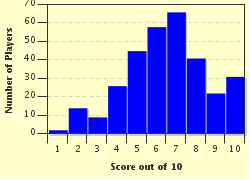Quiz Answer Key and Fun Facts
1. In 1952, Jonas Salk first tested his vaccine for infantile paralysis, at that time a condition which affected tens of thousands every year. What was infantile paralysis also known as?
2. What was the chief medical contribution of Ignaz Semmelweis to the practice of medicine?
3. Lasting from 1918 through 1920, an outbreak of which Spanish-associated disease killed somewhere between 50 and 100 million people?
4. Before vaccines were developed, what more primitive method of the same practice (introducing weakened strains of disease to healthy patients) was used?
5. Which 18th century surgeon was the inspiration for both the story of Doctor Jekyll and Mr. Hyde as well as Doctor Doolittle, and also a pioneer in mapping human biology?
6. Apart from the process of pasteurization, which prevents milk and wine from carrying harmful bacteria, what was Louis Pasteur's greatest influence on modern medicine?
7. Doctor Gregory House, television's fictional master of diagnostics, was based on the fictional detective Sherlock Holmes. Which doctor was Arthur Conan Doyle's inspiration for Sherlock Holmes?
8. As recently as the 1800s, prevailing medical theory was based on the Greek methods set forth by Hippocrates. These theories held that the body was composed of a balance of four elements called what?
9. In 1945, Doctor Walter Freeman experimented on using what implement for a type of surgery, since discredited?
10. Luigi Galvani conducted a series of experiments, Frankenstein-like, for reanimating dead tissue. What medical reading today bears his name?
Source: Author
drowsteel
This quiz was reviewed by FunTrivia editor
gtho4 before going online.
Any errors found in FunTrivia content are routinely corrected through our feedback system.


